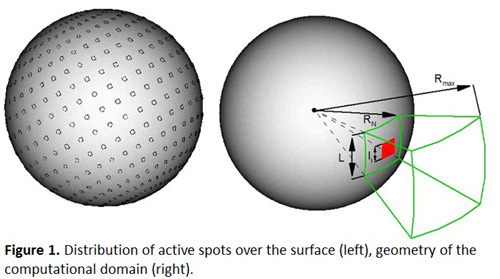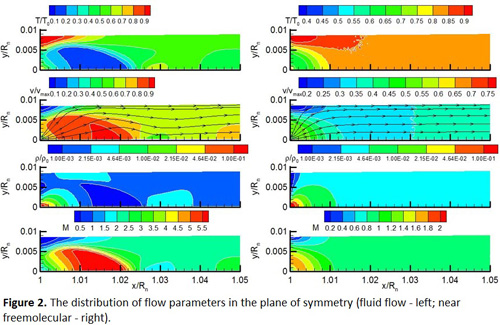Mixing region over a surface of cometary nucleus with small-scale inhomogeneities
- 1INAF - IAPS, Roma, Italy (zvv1661@yandex.ru)
- 2Peter the Great St.Petersburg Polytechnic University, St.-Petersburg, Russia
- 3RFNC - VNIIEF - Russian Federal Nuclear Center All-Russian Research Institute of Experimental Physics, Sarov, Russia
- 4INAF - Osservatorio Astronomico, Trieste, Italy
- 5Universita degli Studi di Napoli Parthenope, Naples, Italy
- 6Southwest Research Institute, Boulder Office, Boulder, USA
In the present work we study the case when gas production Q of the nucleus is formed by the gas emission from a set of closely located (with interval L) spots (see Fig.1) with sizes li much smaller than the radius of the nucleus Rn. We study the structure of the flow in the mixing region for different combinations of li, L, Q and define parameters of the resulting uniform flow. Due to a large number of spots (i.e. L<<Rn) and taking into account the symmetry, it is possible with sufficient precision to restrict the computational domain as shown in Fig.1 (the boundaries of the domain are shown in green, the active spot is shown in red). Note that the Fig.1 is made not to scale.

For the same geometry (i.e. Rn, li, L) but different production rate Q the flow structure in the mixing region can be radically different. For example, Fig.2 shows the distributions of temperature, velocity, density and Mach number (from top to bottom) in the plane of symmetry.The flow close to fluid contains multiple shock structures leading to the non-monotonous and periodic variation of flow parameters (see Fig.2 left). In a rarefied flow the flow structures are diffused and the flow faster become uniform (see Fig.2 right). The flow from inhomogeneous surface can be conventionally divided into two regions: (1) a mixing region; and (2) a uniform flow. The flow in the mixing region is multidimensional i.e. with variation of parameters not only along the radial direction. The uniform flow is a result of viscous dissipation of the flow in the mixing region and it is one dimensional with variation of parameters along radial direction only (as it would be in the case of expansion from a homogeneous sphere).

An important feature of the flow from inhomogeneous surface (with respect to the flow from homogeneous surface) is the occurrence of a non-zero lateral flow velocity in the vicinity to the surface. In all cases under consideration the lateral velocity reached magnitudes comparable with the radial flow velocity. This can have a very strong impact on the acceleration of the dust especially on the initial direction of acceleration.
Conclusions:
- The results of our study show that in the case of inhomogeneous emission from the surface the uniform flow may be formed at the altitudes comparable with Rn. Therefore, substitution by a uniform flow should be done above this altitude.
- The flows from inhomogeneous and homogeneous spheres with the same surface temperature and total gas production rates are not equivalent (i.e. parameters of the resulting uniform flow are not the same as parameters in the flow from homogeneous surface at the same distance) due to difference in stagnation energy. This non-equivalence becomes more pronounced with decrease of flow rarefaction (increase of gas production Q).
- For the correct substitution of the flow from inhomogeneous surface on the uniform flow we propose to use parameters on the sonic surface (and we provide position of this surface and distribution of parameters on it for a broad range of conditions).
- In the mixing region, the gas emanated from active spots expands more intensively then from uniform surface. And furthermore, the inhomogeneity may cause strong lateral flow in the vicinity to the surface. This may have an important impact on the initial acceleration of dust.
Acknowledgements:
This research was also supported by the Italian Space Agency (ASI) within the ''Partecipazione italiana alla fase 0 della missione ESA Comet Interceptor'' (ASIINAF agreement n.Accordo Attuativo" numero 2020-4-HH.0 ).
How to cite: Zakharov, V., Bykov, N., Rodionov, A., Ivanovski, S., Della Corte, V., Rotundi, A., Fulle, M., and Marschall, R.: Mixing region over a surface of cometary nucleus with small-scale inhomogeneities, Europlanet Science Congress 2020, online, 21 Sep–9 Oct 2020, EPSC2020-219, https://doi.org/10.5194/epsc2020-219, 2020.

